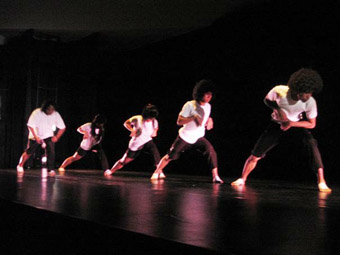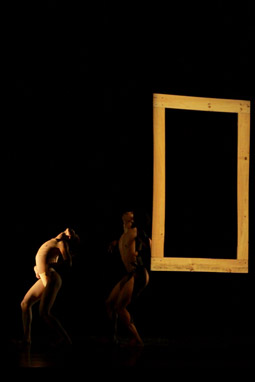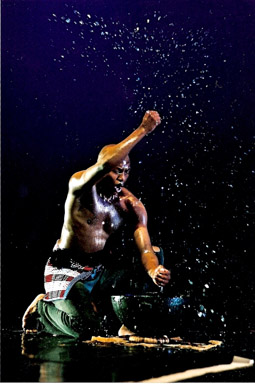 |
From Betamax to DVD photo Phalla San |
With a loud yelp the dancers break into a litany of isolated movements: arm tuck, leg stamp, head jerk. At one count per movement, they dance at a bracing if predictable speed. The dynamic energy, vigorous dancing and clarity of movement in each shape is virtuosic and exciting, at first. But it continues in this vein for the rest of the piece, quickly shifting shapes at a fast and even rhythm, developing in a high impact but monotonous line—there is no climax, only abrupt stops and starts. It’s a long run-on sentence, barely punctuated by stillness and often underlined by yips and barks.
Yes, the dancers change formation and move in and out of the lane of light, but it’s basically different combinations of the same thing. However Siompo's tackling a big topic: “the advancement of technology is a message from tradition” (program note), which is something you probably wouldn’t have understood if not for this one line synopsis. If the advance of technology is the move from one system to another, Siompo’s movements similarly change little to fit his theme. His movement language is a pronounced mixture of Papuan dance and hip hop, with the shapes inspired by Papuan animals (mainly the small kangaroo) and the rhythm consistently fast.
The driving force of Siompo's movement dynamics and his use of universally recognizable sounds are part of his appeal to a global audience. These concrete sounds are also a major vehicle of communication in his work. The beep of electronics, the roar of traffic and the performers’ voices form a medley of the organic and synthetic. In this case the persistent switching of sounds is closely reflected in the changing dance formations, but the consistency of movement seems to indicate that although the world is constantly changing it remains essentially the same.
 |
Home: Ungratifying Life photo Phalla San |
In the blackness two white figures slowly appear to take shape, but they are one—a man in black with a pair of large, white feathered wings, perhaps a depiction of the angel of death, slowly walking to the frame. Here he stands for along time, his few moves a gradually morphing picture as he looks out into the audience—or is he framing himself? He retreats and two young men, wearing only jock-straps, bound into the light. Long arms flaying the air, they energise the previously quiet stage. Even in sculptural moments behind the frame and in rectangles of light their sinuous forms appear primal and strong, while their continual gazing upwards or long reaches down to the floor suggest an unseen spiritual realm.
The men are replaced by a woman walking quietly with her dog, displaying the strong bond between human and animal. They are accompanied by a man who, with his short cropped hair, thin moustache and gaunt body dressed in a neon orange tutu with frilly straps, makes a curious picture that is initially surprising but soon taken for granted. He sings but stops abruptly to provoke the audience, shouting through the frame “What are you looking at?” After which he calmly resumes his song and moves away into the darkness, the dog’s eyes following him, while the girl stands staring out of the frame into the distance, inexplicably serene. The dog seated by her side, without artifice, a symbol of domestication, is perhaps intended to remind us of our relationship with nature.
 |
Vincent Sekwati Koko Mantsoe, Barena "Chiefs" |
These three choreographers delivered humanistic and existential messages, each in an individualistic and surprisingly self-conscious manner. Each appears as the central figure in their own works, their bodies enabling the narrative. Siompo is the odd figure in From Beta Max to DVD, facing away from the rest of the group, a lag to his movements pulling him out of synch, exhibiting a rare awareness of the difference between himself and his younger counterparts. Supriyanto’s is the first body to peer through the frame at the pictures that slowly take shape on stage in his Home: Ungratifying life. His leap into the blackened auditorium aligns him with the audience and invites us to see through his eyes, which is also the function of his choreography. The crux of Beran ‘Chiefs’ is encapsulated in Matsoe’s on-stage figure, his body containing both symbolic and inherent power, his physical journey the vehicle with which the audience navigates the work.
In this closing performance for the 10th Indonesian Dance Festival—with its “powering the future” motto—these mature choreographers can be seen as representative of the 'now' of contemporary dance, examples for future generations of Indonesian choreographers to follow.
Excluding Boi Sakti, who last year announced his intention to stop choreographing, Siompo and Supriyanto are currently Indonesia’s biggest contemporary dance exports (the titles of both their works were in English and not culturally specific). If the selection of emerging choreographers for the festival is anything to judge by, young dancers and choreographers are getting the message loud and clear, showing marked tendencies towards high-art symbolism delivered at an elaborately slow pace or making an impact with a plethora of movement. But that’s to be understood, since learning often starts with mimicry. The real question is should there be more of it?
Choreographers: Jecko Siompo, Eko Supriyanto, Vincent Sekwati Koko Mantsoe; Graha Bakti Budaya, TIM, June 17
10 years ago Melissa Quek began her career as a contemporary dancer in Singapore. In addition to performing, she continues to contribute to the Singapore dance scene as a choreographer and teacher, and is currently Programme Coordinator for the BA(Hons) Dance Programme at LASALLE College of the Arts, Singapore.
© Melissa Quek; for permission to reproduce apply to [email protected]








 back
back